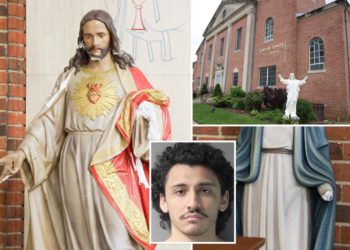Beuford Smith, a socially conscious photographer who created empathetic, abstract and sometimes shadow-filled images of life in Black communities in New York City, including jazz musicians at work and the aftermath of the assassination of the Rev. Dr. Martin Luther King Jr., died on June 7 in Brooklyn. He was 89.
His wife, Evelyn Dickerson-Smith, said he died of cancer in a nursing home.
Mr. Smith came of age in the early 1960s, when Black photographers had scarce opportunities to be hired by mainstream publications. He joined a collective of talented Black photographers in Harlem called the Kamoinge Workshop, a networking group that offered encouragement to its members, helped nurture their skills and told stories about Black people through their photos. Kamoinge (pronounced KUH-mon-gay) means “people working together” in Kikuyu, a Kenyan language.
He was also a founding editor of “The Black Photographers Annual,” a four-volume anthology that was published irregularly between 1973 and 1980 as a showcase for Black photographers.
“We had abstract, glamour, civil rights, everything in it,” Mr. Smith told The New York Times’s Lens blog in 2017. “We did not want to ghettoize, that Black photographers just photographed jazz musicians or poverty scenes.”
On April 5, 1968, the day after Dr. King was killed in Memphis, Mr. Smith brought his camera to Harlem. One photo he took that day was of a Black man enveloped in darkness, weeping as a white delivery man was being beaten on 125th Street. In an interview with the Cincinnati Art Museum in 2022, Mr. Smith said that the anguished man in Harlem was saying, “Please don’t attack him, leave him alone.”
Mr. Smith’s picture of the crying man — which he called one of his favorites — was part of a series taken that day. Among the others were images of a white police officer grabbing a Black man’s shoulder as he pushes him forward during the violence that erupted after the assassination; an officer, in silhouette, watching a fire burn on the street; a branch of the Black-owned Freedom National Bank, with a portrait of Dr. King resting on a funeral wreath behind the front window; and a Black man, shown from behind, holding a bag of groceries and leaning on a mailbox, possibly staggered by the news.
Most of Mr. Smith’s photos were in black and white. But not all of them were mournful.
“Two Bass Hit,” taken in 1972, shows two bass players, standing next to each other, in silhouette, performing at a jazz club, with parachutes hanging from the ceiling. (His photos of musicians often depicted them in shadows or, as in this one, blurred by movement.)
“I couldn’t have staged this any better than this, a profile of a Black musician,” Mr. Smith told the Cincinnati Art Museum.
Other notable images from the 1960s and ’70s include a little girl, her face in shadows, posing defiantly against a wall; a little boy holding an umbrella that has lost its canopy and that is only a handle, shaft and ribs; and an eager-looking man clutching a small bouquet of roses, perhaps looking to present it to his lover.
“His work is eloquent and moving and captured Black people with great intimacy,” Kinshasha Holman Conwill, a former deputy director of the Smithsonian’s National Museum of African History and Culture, said in an interview. “There’s something about a photographer who has that kind of rapport with and love for Black people.”
Reviewing an exhibition of Mr. Smith’s photos at the Studio Museum in Harlem for The Times in 1972, A.D. Coleman said that the photos showed an “adherence to a head‐on, gimmick-free, documentary style, a concentration on urban Black life as the central theme and a consistent confrontation of human emotion.”
Beuford Smith was born on April 12, 1936, in Cincinnati, the only child of Theodore Smith, a porter, and Beulah (Conner) Smith, who took care of the home.
A self-taught photographer, he was inspired to pursue his craft seriously in New York City when he saw the pictures taken by the pioneering Black photographer Roy DeCarava in “The Sweet Flypaper of Life,” a book about life in Harlem with fictional text by the poet Langston Hughes.
After Mr. Smith met Mr. DeCarava in 1965, Mr. DeCarava invited him to his loft to look at his portfolio. He later introduced Mr. Smith to Kamoinge, where he was the first director.
Mr. Smith held jobs at small printing companies until he started working as a freelance photographer in about 1966. He also worked for photo agencies and, in 1977, started his own, Cesaire Photo Agency. His clients included AT&T, Emory University, Merrill Lynch and General Electric.
His photos appeared over the years in Camera, Candid Photography, Photo District News and other publications, and in books like “Soul of a Nation: Art in the Age of Black Power (2015) and “The Sweet Breath of Life: A Poetic Narrative of the African-American Family” (2004), whose cover used his photo of the man holding roses.
Mr. Smith remembered an instance in which he believed racism had played a role in the rejection of his photographs by mainstream magazines. He had tried to persuade Life, Look and other publications to buy the pictures he took after Dr. King’s death, particularly the one of the crying man.
“They said, ‘Oh no, if that had been in color we would get it, we would buy it,’” he told the Cincinnati Art Museum. “But if it had been color they would have said, ‘Oh, if it was black and white we would buy it.’ But if a white photographer had taken it, it would have been there.”
Mr. Smith and his Kamoinge colleagues — among them Anthony Barboza, Louis Draper, Ming Smith, Adger Cowans and Daniel Dawson — were celebrated in the traveling exhibition “Working Together: The Photographers of the Kamoinge Workshop,” which originated at the Virginia Museum of Fine Arts in 2020.
“They were showing what could be done as individuals, but also as a collectivity,” John Edwin Mason, a historian at the University of Virginia, told The Times at the time. “They came of age in the age of Black nationalism, Black self-assertion and self-determination.”
Mr. Smith’s photographs are in the collections of several museums, including the Museum of Modern Art, the Whitney and the Museum of Fine Arts, Houston.
In addition to his wife, Mr. Smith is survived by a son, Cesaire, from a previous relationship, as well as two grandsons and one great-granddaughter.
When the Keith de Lellis Gallery in Manhattan mounted the exhibition “Black Lives: Photographs of Beuford Smith” in 2017, the art critic John Yau, writing in the online arts magazine Hyperallergic, praised the composition of Mr. Smith’s photos, including one of a boy crouching on a sidewalk on the Lower East Side, wrapped in fabric that reveals only his eyes and the top of his head. A few feet away, in the street, a doll, which is missing its arms and a leg, lies amid pieces of refuse.
“It is almost as if the doll is on the orchestra pit with her head turned toward us, while the boy is onstage, about to deliver his soliloquy,” Mr. Yau wrote. “What will he say?”
Richard Sandomir, an obituaries reporter, has been writing for The Times for more than three decades.
The post Beuford Smith, Photographer Who Chronicled Black Life, Dies at 89 appeared first on New York Times.




